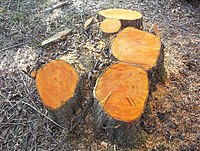
Photo from wikipedia
Abstract Due to historical descriptions dating back to the Roman Empire, we know that coppice is the oldest form of systematic forest utilisation. For centuries, it provided a broad array… Click to show full abstract
Abstract Due to historical descriptions dating back to the Roman Empire, we know that coppice is the oldest form of systematic forest utilisation. For centuries, it provided a broad array of products, energy and services to rural communities, and often in sustainable ways. The type of use was based on available forest resources and the demands of the residents. In compliance with ecological conditions, it proved to be stable and resilient for centuries. Using the example of jointly owned coppices in Lower Austria, the paper investigates the applied social and management systems that ensured its sustainable use and the role played by traditional knowledge. The study also analyses the decline of coppice forestry due to advanced agricultural and industrial techniques that began in the second half of the 19th century. However, the future looks promising when taking into account the changing societal demands. Over the past few decades, coppicing has taken on new meaning for their owners. This concerns the rediscovery of wood as a renewable resource and the appreciation of forests for their role in protecting against soil erosion and global warming. Thus, new actions relying on traditional expertise are set by local farmers, particularly in the open landscape. Not only does this include care measures in the ancient coppice forests, but also the planting of new biotopes as its reduction of wind speed improves the microclimate. Thereby, the cultural heritage and valuable flora and fauna are preserved. On account of the responsible authorities’ support for coppice forest management and with financial aid, local people benefit from the resilience of coppice forests within the context of climate change by making use of this valuable, natural and sustainable bio-resource for current and future applications.
Journal Title: Forest Ecology and Management
Year Published: 2021
Link to full text (if available)
Share on Social Media: Sign Up to like & get
recommendations!